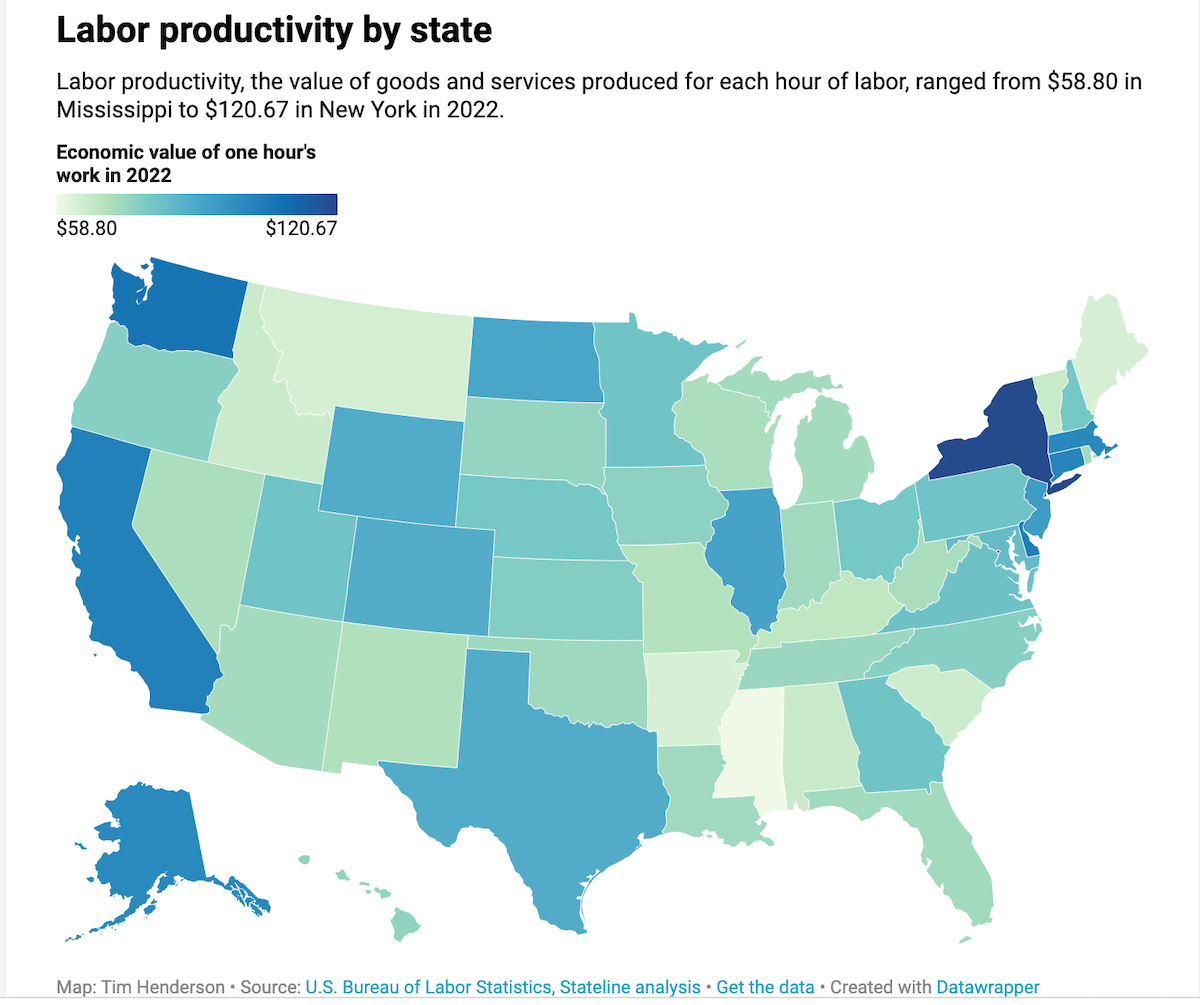U.S. worker productivity has dropped significantly, including in key large states, leaving some economists alarmed by the decrease in a measure that could mean trillions of dollars to the economy.
Labor productivity — the value of the goods and services produced on average by an hour’s work — ranged from $58.80 in Mississippi to $120.67 in New York last year, according to a Stateline analysis of federal Bureau of Labor Statistics (BLS) data released in May.
Thirty-seven states and the District of Columbia saw worker productivity drop from 2021 to 2022 after adjustment for inflation. So far this year, productivity nationwide dropped through the first quarter.
Lower productivity raises the cost of goods, slowing the economy and threatening wages. That hurts residents’ quality of life and the profits that feed tax coffers.
Even states that have led productivity in recent years had decreases between 2021 and 2022 — California, New York, Texas and Washington. From 2007 to 2019, those states contributed more than half the country’s productivity growth.
Even states that have led productivity in recent years had decreases between 2021 and 2022 — California, New York, Texas and Washington.
Some economists see the unprecedented drop in national productivity numbers as an alarm bell, though others see it as an expected reset from pandemic highs, when tech industries in California and Washington soared along with the financial industry in New York. Only nine states had productivity drops when comparing 2019 with 2022.
Gregory Daco, a chief economist for Ernst & Young, called the recent decrease a “recessionary signal” in a May 4 tweet, noting that the five consecutive year-to-year quarterly declines through early 2023 had never happened since the BLS began calculating the statistic in 1948.
“The economy remains in a productivity slump at the moment,” Daco wrote in an executive briefing for clients provided to Stateline by Ernst & Young. Likely reasons, Daco wrote, are labor market churn causing businesses to lose skilled employees as well as unequal access to technology that could speed up work.
Several factors could be at play, economists say. A labor shortage has brought more new and untrained people to work, and the post-pandemic resurgence of service and hospitality jobs has added more low-wage jobs back to the mix.
Experts debate whether the rise of remote work has lowered productivity. And some commentators have argued that the drop is because workers are exhausted from years of pandemic stress.

A map of labor productivity by state. (Courtesy image)
Energy-producing and tourism-dependent states took the biggest hits in productivity: Alaska was down 7.1% to $99.80, Louisiana down 6.1% to $72.90, Nevada down 5.9% to $71.06, Hawaii down 5.3% to $75.39, and North Dakota down 5.1% to $90.28.
That could be another sign of difficulty in energy-producing states, which had a hard time capitalizing on high oil prices last year because of workforce shortages. Hawaii and Nevada could be seeing the impact of a revival in tourism: Those industries are key in those states but are lower-paying on average than white-collar jobs that were more pandemic-proof.
The only sizable increase in productivity was in Idaho, which saw an influx of tech workers moving from California and Washington state. Idaho, which was up 4% to $65.51, in 2021 had the lowest labor productivity except for Mississippi, but in 2022 it surpassed Arkansas, Maine, Montana and South Carolina.
The only sizable increase in productivity was in Idaho, which saw an influx of tech workers moving from California and Washington state.
The U.S. as a whole could add $10 trillion to its economy over the next decade by returning to historical patterns of high productivity growth, according to a February report by the McKinsey Global Institute, a research arm of the consulting firm.
Despite last year’s decline, authors of the McKinsey report still see large states like California leading the way in future productivity, McKinsey spokesperson Rebeca Robboy said.
The report, which analyzed pre-pandemic trends through 2019, cited California as well as Colorado, Massachusetts, New York, North Dakota, Texas and Washington as “both more productive and increasing productivity faster than the US average.” With the updated numbers, only Texas has dropped off the list, Robboy said.
“The 2022 state numbers don’t fundamentally change our story,” Robboy said in a statement. “Some of our higher growth states like California declined more rapidly in 2022. But over the longer period since 2007 the only real change is Texas drops below the average and out of our leading group of states.”
McKinsey does not see the drops between 2021 and 2022 as a sign of recession, and the “jury is still out” on whether remote work is a culprit, Robboy said.
While business leaders point to remote work as a possible cause of decreased productivity, in a phenomenon some researchers call “productivity paranoia,” other economists are skeptical.
Daniel Hamermesh, an emeritus economics professor at the University of Texas at Austin, said the productivity numbers for that state show weakness compared with the state’s large size and fast growth.
“Texas has been a leader in GDP growth but that’s because of its size. It has contributed less on a per capita basis than the other big states: Florida, California and New York,” Hamermesh said. “In terms of growth in productivity over the longer term, it looks pretty bad. It’s not a happy thing for Texas.”
While business leaders point to remote work as a possible cause of decreased productivity, in a phenomenon some researchers call “productivity paranoia,” other economists are skeptical.
It’s hard to measure the difference between remote and on-site work productivity, said Jose Maria Barrero, an economist and co-founder of the WFH Research project, which analyzes the phenomenon of working from home.
“I am very skeptical that remote work is dragging down productivity. There are more mundane reasons to explain why productivity has fluctuated,” Barrero said. For the average worker, 30% of work is now done at home, and that figure hasn’t changed much in the past year, he said.
“Profitability at the firms employing these knowledge workers rose for pandemic-related reasons,” Barrero said. “2020 and 2021 were bumper years for the financial sector as firms sought cheap capital, and there was a similar boom in tech.”
Pennsylvania Capital-Star is part of States Newsroom, a network of news bureaus supported by grants and a coalition of donors as a 501c(3) public charity. Pennsylvania Capital-Star maintains editorial independence. Contact Editor John Micek for questions: info@penncapital-star.com. Follow Pennsylvania Capital-Star on Facebook and Twitter.

This news article was written by Tim Henderson of Stateline. It originally appeared at the Pennsylvania Capital-Star and is republished here with permission.
Before you go...
Please consider supporting Technical.ly to keep our independent journalism strong. Unlike most business-focused media outlets, we don’t have a paywall. Instead, we count on your personal and organizational support.
Join our growing Slack community
Join 5,000 tech professionals and entrepreneurs in our community Slack today!

Entrepreneurship is changing, and so is the economic development behind it

Tech Hubs’ new $210M funding leaves Baltimore and Philly off the table

Here’s what to know before using AI to craft your brand’s social media posts


